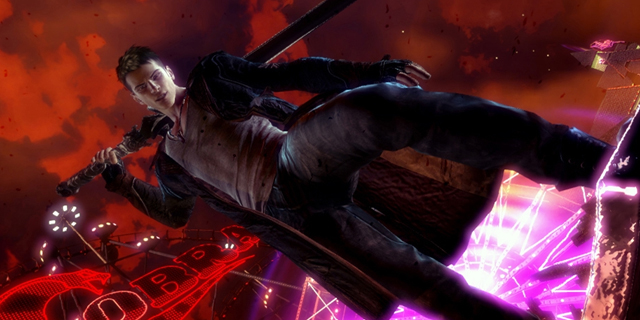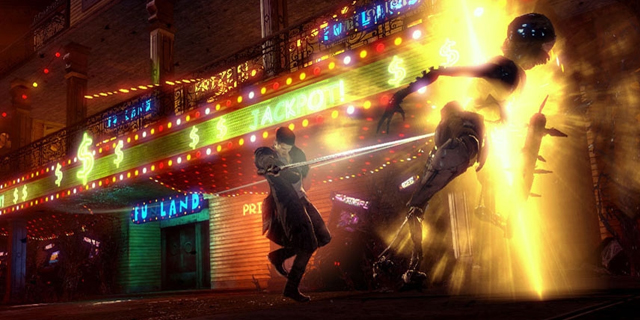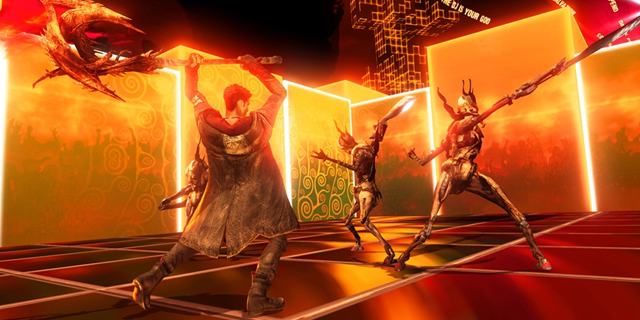
When rebooting a franchise, you have to take into careful consideration what made that franchise so well-liked to begin with. When rebooting a franchise with a different developer at the helm, your chances of appealing to hardcore fans of the previous games has been reduced exponentially. Despite the outcries those fans, DmC: Devil May Cry manages to capture everything that was great about the original games, while carving out an identity that’s all its own.
Taking place in Limbo City, DmC follows a young Dante who is dragged into an underground conflict between a supposed terrorist group known as The Order and a large organization of demons that have been secretly controlling the human population of the city for years. Because of his half-demon heritage, he can not only see the demons, but is one of the few with the power to stop them. Dante is a brash and cocky young man who doesn’t care about the conflict or the lives of those at risk, but as the conflict grows, he begins to understand his role is more central than he initially believed.
From the onset, Dante is a character you have a hard time caring about. Thanks to his connection with a young woman named Kat and rediscovering his past, he grows into a likable, heroic figure by the end of the game. The story never takes itself too seriously, and when it does it usually pays off. Taking the atmosphere from the previous Devil May Cry games and bringing it into a more politically charged story seemed like a recipe for disaster, but the strong characters, funny writing, fantastic pacing, and some surprisingly poignant moments help it succeed.

Those going into DmC expecting a replicated version of the combat from the previous games might be disappointed. The combat isn’t as fast, but with a large host of different weapons and a ridiculous amount of combos to unlock, there is plenty of depth to be found. Once you unlock a decent number of weapons, being able to switch between them on the fly and string together intricate combos is what makes the combat such a joy. The best part is you don’t need to rely on those combos if you so choose; the game is forgiving enough so newcomers to the franchise or action games of this nature will be able to jump in with little to no problems.
Like in every DMC game, as you perform combos, you earn a style ranking that goes up the more “stylish” and complex the combo is. For example, if you simply rely on one or two weapons, you’ll find it hard to earn above a B, but if you continue to switch your different weapons and try new combinations of attacks, it becomes much easier to get an S rank or higher. These rankings are important if you want to continue to buy new combos for Dante and his many weapons, but they aren’t essential.
Being able to string together different weapon attacks was a little difficult for me at first, but with enough practice, I found myself quite comfortable with swapping on the fly and was able to make the best of even the toughest enemy encounters. And the large variety of enemies, including some that can only be damaged by certain weapons, provided plenty of opportunities to try out new weapon combos throughout the game.

The biggest problem with the combat is the camera. The lock-on system has been a series staple, and yet it is gone in DmC, which can make certain encounters difficult. In many scenarios, the camera is fine, never interfering with the fights or my ability to attack certain enemies. However, there are times when the camera would refuse to cooperate or simply ignore certain enemies I tried to attack, even when I attempted to take direct control over it.
There is no manual lock-on function, but there are moments when the camera would “lock” onto certain enemies that you are fighting, even when an off-screen enemy was about to attack. For example, there was a particular platforming section that involved you getting from one end of a tunnel to the other before a timer ran out. The game threw enemies at you, but in one instance I realized it was best to ignore the last group of them when time was running short. Instead of letting me move the camera ahead to carefully avoid falling into pits, the camera continued to focus on the enemy I was so desperately trying to escape from. These instances aren’t frequent, but they come up often enough that it became a bit of a hindrance.
The most exciting and visually compelling change to DmC compared to the previous games is the emphasis on Limbo and how that shifts the environments in crazy ways. Almost all of the levels in the game take place in Limbo, the place where the demons are free to roam and the world itself, from the buildings to the street lamps, is out to stop Dante. The most ordinary looking areas can be morphed into creative (and demonic looking) battle arenas that showcase Ninja Theory’s seemingly limitless creativity when it comes to creating brilliant levels. These environmental changes continued to surprise me from the opening mission all the way to the final few missions, with many in particular that really took advantage of the game’s visual style.
While there are bad platforming moments (as mentioned above), the platforming sections in DmC are surprisingly polished and cleverly designed. There are also plenty of branching paths that allow you to find collectibles, such as lost souls, which earn you more red orbs to spend in the store, and keys, that unlock doors to secret missions. The secret missions give you a set time limit to complete certain objectives and range from simplistic to brutally tough. Those who seek these out will find a nice variety of objectives to complete and it gives you plenty of reason to explore these carefully constructed environments.
DmC is an excellent reboot of a much-beloved franchise. It remains true to a lot of what made those games great to begin with while establishing that it isn’t just out to remake them. It is a fresh start for a franchise that was beginning to look stale. Some fans will never be able to accept it, but for those willing to give it a fair chance, you might just be pleasantly surprised.
Pros: Excellent visuals, brilliant level design, combat is as fun and frenetic as ever, solid writing and an interesting story
Cons: Camera tends to be problematic at times



















